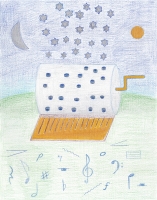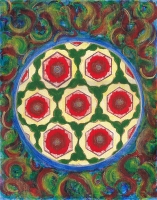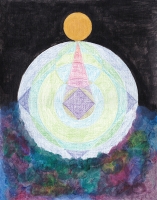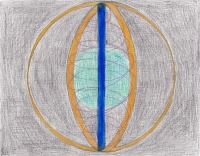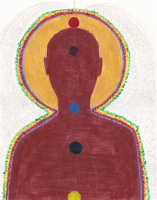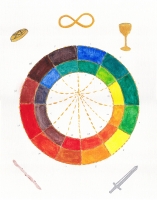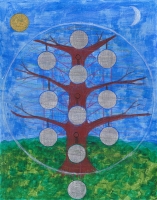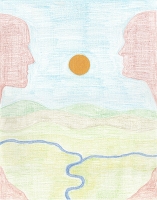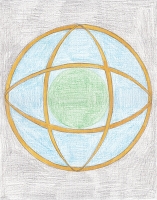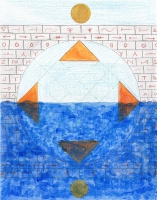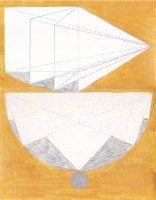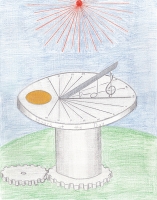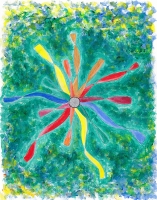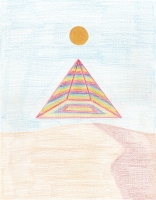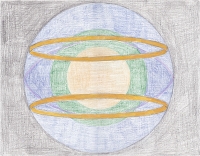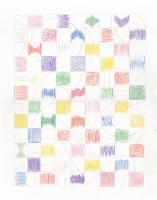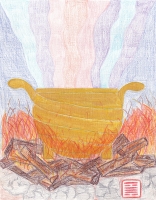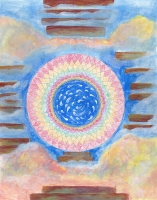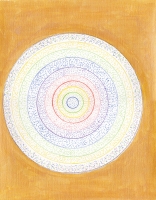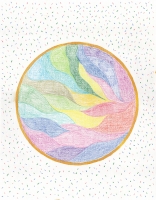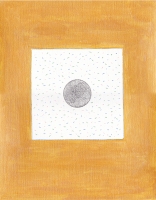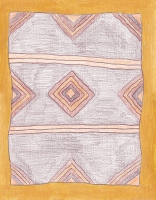Hours of the Day
Paintings for Musical Interpretation
These works are based on a state of being during each hour of the day. The performance may last up to 24 hours, with one piece being performed each hour using a new melody for the clock chimes with a different number of notes at the end for each hour. Each piece may or may not last throughout the hour. The pieces may be performed within any timeframe not considering the actual passage of time in a day, to an effect of its own. Participants and audience members should be encouraged to sleep if they would like to. Projections may be played in the background.
12 Midnight – Music Box. In this picture, we see a music box sitting on the surface of the Earth. Above the music box are 22 stars. The stars may correspond to the Major Arcana, paths in Kabbalah, or shrutis in Indian music. In this piece they may simply correspond to notes in a melody. This image has a much more indirect correspondence to music – it simply represents music itself as it relates to the cycles of the sun and moon and the heavens. Melodic minor modes seem to convey celestial and night music. One might play freely, varying tempo, and melodically, as a music box, associating the stars with melody, and the sun and moon with other motifs and chords. Below the music box are several music symbols that one might associate freely. We might think of the piece as a stream of consciousness and melody as one is beginning to fall asleep, with the sun no longer visible, and the moon high in the sky as alternate musical ideas.
1AM – Kaleidoscope. Kaleidoscopes are among the more common visuals used with music, along with Chladni plates, Lissajous figures, and liquid light shows. Their correspondence to music is usually not very direct other than by synching to rhythm, thus, another interpretation has been provided. Within the kaleidoscope are reflections forming what appear to be heart chakras and are representative of the soul gazing ritual of staring into another’s eyes. The kaleidoscope is surrounded by the prima materia or the essence that permeates throughout the universe, as the world itself is surrounded by this same essence, giving rise to its gravitational field. This aspect could be interpreted as tuning up or preparing to play in a more organized manner. The reflections in the kaleidoscope can then be interpreted as triads or seventh chords being reflected over a given note or notes or transposed, and as cells with three or more notes or tetrachords of four adjacent notes being reflected or transposed in the same manner, forming polytonal runs up and down. When chords are reflected or transposed to another key, if one avoids minor ninths above the fundamental, polytonal chords may be formed without harsh dissonances, as the minor ninth above another note in a sequence of thirds seems to “blot out” the character and color of the harmony, being the most dissonant of intervals. We might call this technique “kaleidoscoping”.
2AM – Inner and Outer Worlds. In this painting, there is a golden circle, perhaps representing the sun, being surrounded by the darkness of space. This darkness is perhaps best represented musically by soft clusters of notes in the lower registers. The sun is ever present, though it does not illuminate the entire painting. The sun may be represented by the fundamental tone or a key and its associated tonic chord, perhaps from the natural harmonic series, or a dominant seventh with a sharp eleventh. From the sun, rays of light project outward over half of the inner world, or the Earth. Between the Earth and the Sun there is another circle, though it is not clearly visible, representing a lens though which light is visible, though the essence from which light has emanated is present everywhere, even the darkness of space. Outside of the center world there are four circles. These four worlds or circles may correspond to four other keys, chords, or tonalities. Beneath the worlds there are purple, blue, and green clouds, perhaps reminiscent of a nebula. This “nebulous” material may represent the subconscious in which dreams are now taking place. These colors are similar to those in the four worlds. Musically, this could mean that although the tonalities of the worlds are present, they are made unfamiliar by blurring together, perhaps in polytonality, as would be characteristic of a dream in which visual objects are distorted in their dimensions. We should note that the light that is visible is not the same color as the light from the four worlds outside of the lens – this lens meaning the perception of our own eyesight and hearing, thus, the colors and harmonies as they may be inaudible and invisible to us outside of our own perception may be encountered in the dream world. In the circle representing the Earth is a square, and in the circle representing the outermost world is a square. The square in the outermost world meets at a point from which the visible light reaching the Earth emerges, thus, visible light reaches the Earth in all directions, though not directly, its essence being contained in the clouds of the nebula, as well as the Earth itself. Musically, this would mean that there are proportions to the piece that exist throughout, perhaps in form.
3AM – Poles. In this picture we see a sphere with a vertical pole. Energy travels up and down the pole in a spiral. Two outer rings encircle the inner sphere. Musically, each of these is represented by a line. At the points of intersection, the lines converge becoming monophonic, then with one line giving the impression of two, becoming polyphonic near the center, and then two lines giving the impression of one. Notation has been completed for this piece. Additional elements may be used for the sphere and the energy travelling, present throughout the piece as improvisation or ostinato.
4AM – Refractions. Refractions are a shifting of the angle of light as it passes through a transparent object. In this image, we see light of different colors passing through a lens in the center at different angles. The lower part of the lens has three aspects, or potential sources of light, with one being white having all colors combined, one black or having absorbed all of the light, and one being gold having been reflected from another source. One might think of these three sources as three ragas or chords, being altered slightly as they pass through the lens. Lenses have a focal point in which the light converges. We might think of the portion at the top as light emerging from a focal point in all directions after having been focused. We could think of this then as the source ragas or chords being focused to a single idea – a motif, chord, or raga, then to a single note, and spreading outward in all directions from that note. At the bottom of the picture we can see light entering a concave lens, a flat lens, and a convex lens, perhaps representing sections in the form of the piece in which the type of lens has changed. The concave lens would have light or musical notes disperse without being focused, or having already been focused then dispersing outward. The convex lens would focus light to a point, then dispersing in opposite directions –perhaps outside ragas - as has been described in the center image. The flat lens would have no focal point and light or the musical notes would pass through to the other side without being altered. This is representative of a dream state in which our concept of visual perception is not entirely discernible and objects may appear distorted or disproportionate.
5AM - Halo. In this picture we see a person meditating. Solar halos are caused by a combination of reflection, refraction, and diffraction, usually from water droplets where the sun’s light passes around a person’s head, and have been thought to mean there is a divine presence. Energy cycles throughout the body, traveling along lines or nadis channels connecting the energy centers. There is also energy present just outside of the body that may contribute to the halo or aura caused by the light, becoming more subtle further away from the body. There are seven energy centers, two of which are not shown. In this work, one might interpret the energy centers as the notes within the ragas, or each a different raga. When thought of as different ragas, each note would be altered for each energy center, also being associated with the degree of that scale. As the energy cycles throughout the body, the ragas will shift slightly, with one note being changed at a time. This can be done in order from the lower energy center to the top, or being thought of as the most inner raga to the most outer raga. The energy cycles around the body, perhaps providing melodic contour. The performers would follow a contour based on the body and the energy surrounding the body, perhaps using the nadis connecting chakras as guides, and from the inner raga to the outer raga altering one note at a time, though with root and fifth remaining the same – perhaps representing the root and throat chakras or crown and solar plexus chakras.
Dawn 6AM - Infinity Chord. In this piece, four or more players may be called for in its realization. There are two circles of fifths, one inner and one outer, separated by a major third. The sequence as one circles around is of an endlessly rising chord that goes through all keys. The sound sources or players are best positioned in alternating Left-Right pairs then Top-Bottom pairs, such that when one moves throughout the circle perhaps on the line between the inner and outer circumference, they will hear a constantly shifting chord. Four other symbols represent the four positions of the sound sources or the four players as they may represent the positions of the sound sources where one cannot move through a physical space. The golden ropes meet at a point, as though a kind of circus tent, and may signify that they are guidelines for which notes to play, though perhaps others related may be played in variation. Each player may move around the circle of fifths with left and right sides separated by a major third, the second player being a fifth below the first player on both sides and changing pitch at the same time as the first, while both sides take turns changing pitches, such that major seventh and minor seventh chords alternate in succession, or each player may play through the chord in alternating major and minor thirds with right and left sides separated by fifths with thirds paired on each side. Depending on how rapidly the notes shift the desired result should be a gentle hypnosis.
7AM – World Tree with Sephirot. In this painting we see a tree within a sphere. The trunk of the tree may represent the axis upon which the world rotates. Outside of the sphere of the world are the sun and the moon, and just below is the lower Sephirot, Malkuth. The sphere of the world is not representative of the world in which we live, but of the essence of our existence within this world and contains all of the Sephirot except one. Thus, the roots of tree or Malkuth extends into the world we can experience directly. The Sephirot are without color, and though they embody certain manifestations of the energy from which thoughts, actions, and the world originated, they are not yet tangible in form. On one hand, there is the tree itself. Beginning with certain scales or notes from which to choose, and building upward from their relationships, branches can be separated outward, thinking of each branch as containing only a part of what is present in the trunk, though branches on either side may contain similar notes. On the other hand, there are the 10 smaller spheres within the larger one. We might note that there are seven levels in the sphere, if one considers either side alone, which may be likened to the energy centers or Chakras in Indian literature. These might best be represented by certain scales or modes and associated chords. Between these scales and chords, one might consider their connections, which may contain notes present in both centers or Sephirot and such connections or paths may be considered as progressions or resulting in the form of the piece. We might think of each Sephirot as a unique set of wind chimes hanging from the braches of the tree. The tree represents a shift from a state of sleep to one of wakefulness as one would climb upward.
8AM – Anima and Animus. Here we see the face of a man and a woman on opposite sides of a canyon. The canyon has been carved by the river in the center, the water from which appears to have come from the hills in the distance. The hills have different levels and each has a unique contour. The contours would suggest a polyphonic texture in which three or four lines play in counterpoint. Above the hills is the sun, perhaps being represented with a chord or mode, perhaps a Lydian dominant scale. The two faces have contours of their own and both belong to the stone from the earth in the valley beneath. Thus, the piece is should be interpreted as a wearing away of the stone by water with lines that flow uninterrupted. The two faces opposite one another represent the aspects of male and female that exist in both men and women, physically, mentally, and spiritually. The light of the sun brings us to this awareness – that we are formed from the same material or essence.
9AM – Gyroscope. In this picture we see a sphere with three rings encircling it. Notation has been provided for this piece, though other variations may be used. Each line will converge into a monophonic line at the points of intersection, and become polyphonic moving away from the monophonic parts. This can be accomplished by writing three separate lines and combining them with hockets giving the impression of one line and single lines giving the impression of more than one line, or by writing each section with a different texture independently.
10AM – Reflections. In this painting, we see a circle with four triangles in the center. The triangles have been reflected over two perpendicular lines, and also over a horizontal line representing water. Other lines connect the points that have been reflected, being perpendicular to the lines of reflection. The four triangles are perhaps best represented by triads, and the reflecting lines by notes, perhaps being the open strings on an instrument itself. We might take note that there is a medium of reflection – the water, which may itself be represented. As one reflects on their memories, they become less clear as time passes, thus, the reflections on the bottom part of the painting are more difficult to see, being obscured by the waves. We see a bridge over the water, which has been reflected horizontally and vertically. Each level of bricks is perhaps represented by a melody line, and each of the symbols on the bricks may be associated with a technique as it is applied to the melody. In the reflection of the bridge on the water the symbols are more difficult to understand, and thus, some of the meaning has been lost. The reflection on the water may be played from memory, being reliant on what the performer remembers from the bridge after it has been played a first time. Over the bridge is a sun rising, and its reflection on the water below can also be taken into consideration. The sun may perhaps be represented by a more central idea, such as a chord or a melody.
11AM - Projecting. In this painting, we see light being projected onto walls from different angles. When our mind is in a state of projection, it is no longer focused on the present. It is focused a time in the future and perhaps a different place. One can direct the light towards a flat surface and expect to see what they had desired to see, however, as time may pass, as is demonstrated by the alternate angles of the light in the lower image and alternate angles of the walls in the upper image, the desired result becomes distorted. Just as the hands of a clock would turn to form a different angle at a time in the future, the walls and points from which the light is being projected have changed. What this means musically, is that the desired sound is never reached. It exists as a starting point in imagination, but with each passing hour, the intervals of pitch and rhythm have been altered by being multiplied, perhaps bending the pitch to be slightly out of tune and wider, then a melody being played in which each interval has been widened, until it is no longer a melody at all, but a sequence of pitches. The starting melody and rhythms are represented by the circle at the bottom.
12 Noon – Sundial. In this picture we see a sundial standing upon the earth, the column from which it is supported representing the axis of the earth and the passage of time. Attached to this column is a gear, as though part of a clockwork. Each tooth of the gear might be thought of as having a note attached to it, thus forming cycles of different lengths, and suggesting a polyphonic rhythm perhaps representing the rotation of the earth as it relates to other rhythms. The teeth of the gears in the clockwork can be thought of as the rhythmic atoms of the pulse, being indivisible, as is common in the music of Africa and other regions. Above the sundial is the sun, casting rays in all directions, seeming omnipresent throughout the piece, and perhaps represented by the key center. The shadow is cast on 12 noon, and represents becoming aware of the aspects of oneself that are not previously known, again, reconciling oneself with being human and having transient nature, both in thoughts and actions, as well as in physical existence, and sharing in that experience with all others especially in understanding the reasons for their thoughts and actions. The part of the sundial that casts a shadow is supported by musical symbols – a flat, a note, and a clef, denoting that as the angle of the sun changes, so too will the key or line that is represented by the note “G”. Thus, one might shift throughout the different keys as the entire piece progresses – the sundial representing the central aspect of it, or throughout the keys in this part of the piece associated with the hour 12 noon.
1PM - Maypole Dance. In this painting there is a central pole represented by a silver circle. Lines come inward from the circumference of the circle, indicating that it is the axis on which the other parts of the piece rotate. This could be musically represented by a drone, perhaps shifting in dynamic intensity, as the lines go outward and inward interacting with the ribbons tied to the pole. There are seven colors of ribbons – Red, Orange, Yellow, Green, Blue, Purple, and Gold, in reference to a song I had written in 2012. There are seven colors, and this perhaps corresponds to the seven degrees of a scale. Each ribbon may have a melody associated with it, played beginning on a different degree of the scale. Each color forms a pair, and the two melodies should be mirrored retrogrades of one another. As the person in the dance moves outward, the melody would play and octave up, as the person would move inward, the melody would play an octave down or at the starting position. Each melody would be played with all of the others moving in the opposite direction, then the second melody would be played with all others moving in the opposite direction, and so forth until all 14 melodies have been played. Alternately one might consider only the two melodies played at a given point on the circle throughout the piece as they would move around the pole. If played by a quartet, pairs of players should alternate. The different melodies should be slightly staggered so that no two begin at the same time, though there should be no rests between the motifs where no music is played and the motifs continue one after another. The blue and yellow flowers may be symbolized by sparse interruptions in the piece, so as to make the melody lines more varying. The green grass then may be interpreted by even more slight ruffling of the instruments by other players.
2PM – Drifting. In this picture, we see a pyramid floating in the air. Above the pyramid is a golden sun, and below are dunes with a shadow cast on one side. The sky is clear and without clouds. We might interpret these things as being part of the physical world, and the pyramid as part of thought or within the spiritual. As one would become bored with their surroundings – a desert and a glaring sun, they begin to create a separate life within their thoughts, and thus, the pyramid drifts above. The interpretations of the surroundings are perhaps minimal – we have the desert sands and the sun, perhaps with the contour of the dunes and their shadow side having an interplay. The pyramid is multicolored, has four triangular sides and a base. This lends itself to the interpretation that each side, perhaps a motif or section in form begins with a single idea at the top, being lengthened as one approaches the bottom, and changing in color or tonality. The four sections would each build upon an idea adding an extra beat or measure, shifting in which raga or key is used as one approaches the bottom. The base of the pyramid might be interpreted as shifting inward and outward in raga or tonality. Alternately, one might think of each side as a different part or performer, each playing together as they approach the bottom, shifting in tonality and adding bars or beats.
3PM – Tropics. Notation has been provided for this piece. In this picture we see two rings representing the Tropic of Cancer and Tropic of Capricorn. Connecting the two tropics is a purple line, representing the path of direct sunlight throughout the year. As one progresses throughout the piece, the texture gradually shifts from being monophonic at the Solstices, to Polyphonic at the equinoxes. Alternate musical elements may be used for the spheres in the center.
4PM – Concentration. In this painting we see squares with colors and contours. The squares are useful as a starting point for projects of any medium, as each square may contain a symbol or a work itself. The grid is somewhat rigid and without feeling, though it provides boundaries for what it contains such that there are constraints to ideas that are more open to interpretation. The squares are checkered, with colored squares having different techniques to fill them, some being more filled than others, and white squares having curves and straight lines that may act as contours. These aspects of the picture would perhaps work best with timbre or musical technique, being thought of as contours for dynamics or pitch, and the manner in which the colors have been drawn might correspond to how an instrument is bowed. There are 12 vertical squares, which may correspond to the chromatic scale. Apart from this, one might think of any musical element as corresponding to either the vertical or horizontal layout or to both – rhythm and form having to do with time, harmony and melody with pitch, technique or timbre and dynamics perhaps being contained in each square, with texture perhaps being thought of as the overall layout of the image – perhaps the number of squares either vertically or horizontally may represent the number of performers or lines.
5PM – Nourishment. In this picture we see a cauldron. The cauldron is not merely a pot used for cooking, but is comprised of two serpents. The serpent represents a gateway between worlds of the spiritual or thought, and the physical, transforming what once lived into nourishment in order to sustain life, eliminating the waste that cannot be used. The two heads of the serpents form the handles. In the alchemical process of attaining philosophical mercury, which may be represented by the caduceus or two serpents spiraling around a staff, one dissolves the opposing symbols underlying their thoughts in order to make their existence more fulfilling – perhaps traits attained from either of their parents or ancestors on either side. The cauldron itself may represent the mind or one’s being, and its contents their thoughts and experiences. Once this difference is dissolved, all that is left is the two snakes spiraling around one another, no longer a part of the cauldron. This may be represented musically by two alternating lines or parts in opposition becoming dissolved into harmony. The cauldron has feet, perhaps represented by stronger intervals such as fifths. Beneath the cauldron are flames, perhaps represented by more rapid movement in dissonant scales or modes, and logs, represented here in a cubist manner and perhaps by more angular dissonant chords and intervals. Encircling the cauldron are several stones, perhaps then represented by more robust intervals and a consonant, minimalist cyclical style. From the cauldron comes colored smoke, or what is being evaporated from the conflicting symbols, perhaps being consonant or polytonal with ragas or impressionistic harmony. The piece may progress from the bottom upward, beginning with the stones, the fire and wood, the feet, the serpents and contents of the cauldron, and the steam or smoke. Thus, one cannot search for the philosophical mercury as a means to “create” gold – it exists everywhere throughout the universe and as the essence of thought itself within a Zen-like clarity.
Dusk 6PM - Shrutis Becoming Separate from Nadas and Dhwanis. In this painting, there is a center with spiraling comets. The center appears to be another world or sphere. Musically, this would mean harmonic sounds have not been formed yet, and as such, sounds whirl around and around. Outside of this sphere there is another of bright colors in a spectrum with lines meeting one another at the edge of a circle and at points perpendicular to the edge of the center sphere. These are perhaps best represented by glissandi, in attempt to find the points of harmonics on the strings. The colors may represent different positions on the strings, or the different strings themselves. Outside of this circle, there are 22 steps. Some of the steps appear to be covered by clouds. One might interpret this musically as points of harmony having been found and perhaps ragas beginning to be constructed, yet still a mystery and having other musical sounds obscuring them.
7PM – Tunnel. In this painting we see many concentric circles with points of light within each circle. In the outer ring, the points of light are Red, Green, and Blue, or the colors the eyes’ cones are sensitive to. The colors tunnel inward from the outside. This is representative of a heightened meditation state that is neither beginning or coming to a conclusion. Musically, this would suggest cyclical rhythms or repeating motifs, perhaps at a faster tempo than some other the other pieces, though perhaps beginning slowly. Each ring might be considered a cycle, continuing until entering the next, and perhaps shortening the length of the motifs or phrase in the cycle, and changing the raga or color of the motif. Once the center has been reached, the cycle may begin again.
8PM – Shifting. In this picture we see a golden circle surrounded by colored points of light. Within the circle are blankets of colored light shifting around. This represents a more advanced state of meditation, perhaps one in which a state of conclusion is being reached. Each of the colors meets with those adjacent, and has a wavy contour suggestive of water or of ocean waves. Musically, the outer part of this piece may be highly pointillistic, being played in with staccato in many registers, while the inside is melodic and perhaps polyphonic, with many contours coming to meet with one another, and many colors, perhaps being variations of the notes in each raga. Form and rhythm are difficult to ascertain, but may be very open and free flowing, though perhaps cyclical. One might create a sense of free-flowing blankets of color or ragas, each meeting with one another, over a background of a colorful, sparse, sparkling musical character, perhaps using chimes.
9PM – Meridians. Notation has been provided for this piece. In this picture we see a sphere encircled by three meridians. The meridians meet at the two poles. Each meridian is represented by a line in the musical texture becoming monophonic at the poles, and polyphonic near the equator. Additional musical elements may be used for the center sphere.
10PM – Origin. In this picture, we see a square. Inside the square is a black circle, surrounded by colorful points of light. This represents an advanced state of meditation, perhaps one nearing conclusion. This end state may be associated with having reached the origin of the soul or having acknowledged the innermost part of one’s own being. Musically, one might consider the square first, as even, long tones stretching out for the full lengths of each breath, with equal and evenly spaced rests between each tone forming the sides. This may be performed with others exchanging rests and notes, or with each person beginning and ending each note at any time in their own square according to their breath. Within the square, the light may be represented with simple chimes, cymbals, or harmonics interspersed throughout. The circle, then, might be likened to an inner silence that permeates throughout the piece – or an awareness of the silence between the notes ever present as it plays in counterpoint to the sound, and of the silence before beginning and ending the piece.
11PM – Blanket. In this picture, we see a blanket, similar in pattern to those used in Navajo traditions. The blanket has three sections; this perhaps lends itself to an association with musical form, with two of the sections perhaps being opposites of one another as inversions or retrogrades, and the section in the middle also able to be reflected along a center line. The stripe between each of the sections may suggest a brief rest. Within each section there are three shapes, being parts of a square or a square itself. Considering the sections of the squares when put together or thinking of the blanket as being rolled either vertically or horizontally, there are four squares in total. The sections of the squares may thus be considered parts of one another, being fragmentations of longer phrases. Within each square are four outer squares, with one inner square. One might interpret the inner squares as being shorter phrases being divided into four sections. Rhythmic associations may be made as being in quadruple meter. The phrases around each inner square may be shaded differently, and as such, being lighter or darker in character harmonically or melodically, in contrast to being a different color or raga or tonality. Not visible are the threads in the weaving that produce lines, and as such, they may be interpreted as left to right readings for each part, producing an alternate interpretation, though the patterns themselves suggest phrases or sections divided into four parts, within a larger form or three sections, the phrases being of different lengths around a center square, perhaps in 4/4 time, with varying shades in melody and harmony. The blanket suggests a state of preparation or preparedness.
